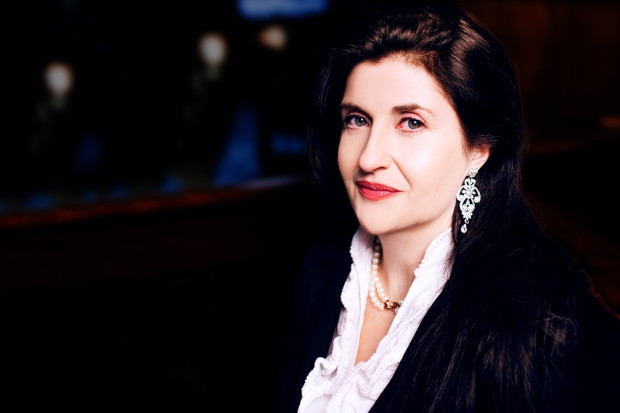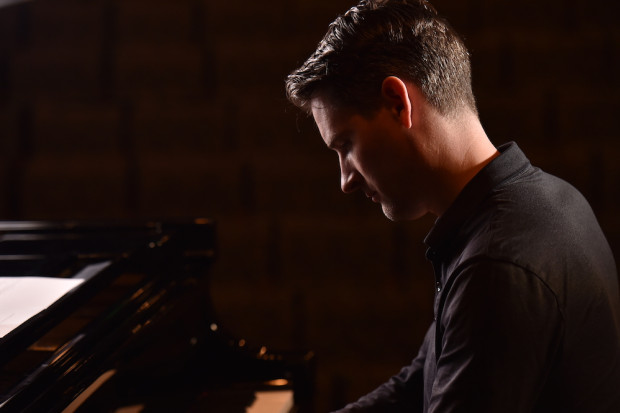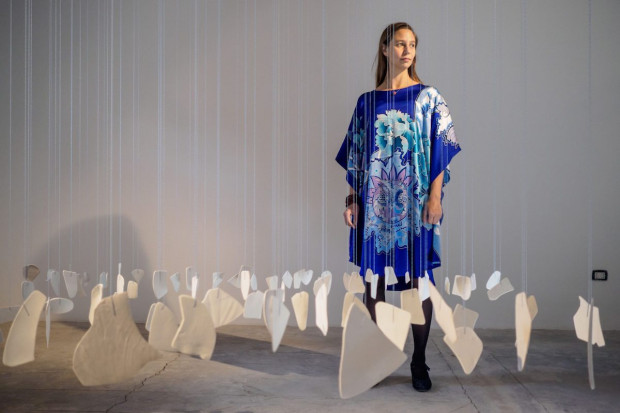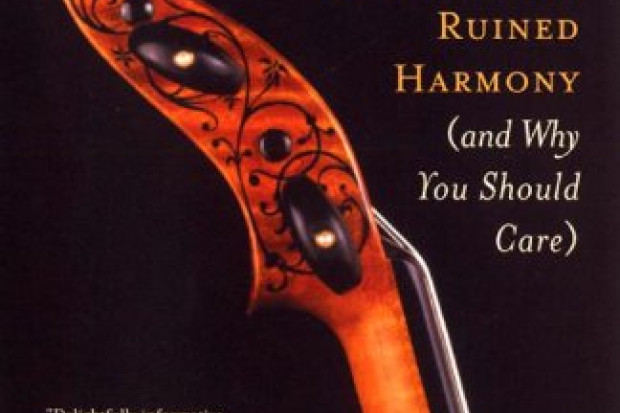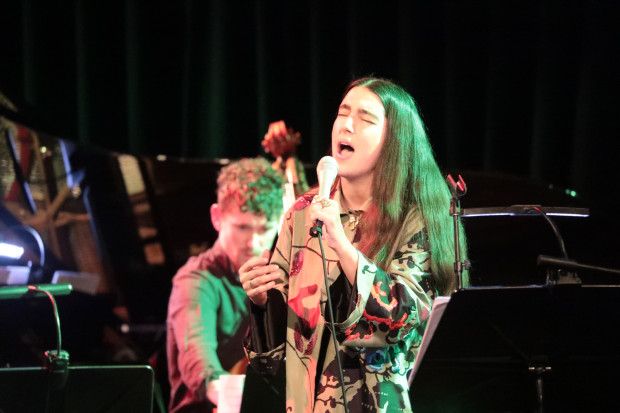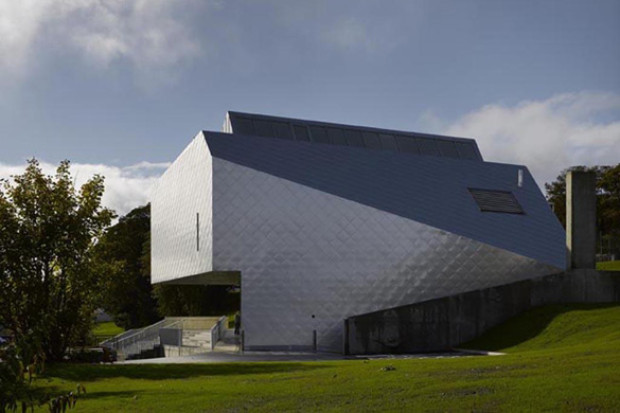
Xenia Pestova Bennett and Ed Bennett performing Karlheinz Essl’s 'Gold.Berg.Werk'.
Radical Bach?
Ergodos has a long track record of creating compositional interventions around famous compositions, including such totemic works as Bach’s Violin Partita in D minor (2013) or Beethoven’s String Quartet op. 132 (2020). In their curated performances, specially commissioned pieces were inserted between the movements of the historic work and these acted as reflections of different aspects of the original composition. It is therefore not surprising that Ergodos would be interested in producing a recording of Karlheinz Essl’s Gold.Berg.Werk, which intersperses electronic interludes between movements from Bach’s Goldberg Variations. While the press release describes it as ‘a radical re-interpretation of J.S. Bach’s Goldberg Variations,’ this probably oversells the work considerably. However, the concept and its execution do raise a number of interesting questions.
The piece dates from 2002–3 and was originally conceived as a piece for string trio and electronics. A selection of movements from the Goldberg Variations was performed by string trio, with movements that were deemed to be unsuited for strings omitted. The chosen movements were rearranged into groups of either ‘character variations’ or canons and five electronic interludes were inserted into the structure. The starting point for the electronics was a recording of the trio playing a harmonic reduction of the opening Aria, which was then manipulated using granular synthesis and a Max/MSP programme developed by Essl. For performances that the composer is able to attend, the interludes are generated in realtime, but there is also a fixed media version that can be ‘performed’ and spatialized in realtime when he is not able to be present.
The Ergodos recording documents a new version of the work created for pianists. This results in a number of modifications to the piece. The string trio version retained nineteen of Bach’s movements grouped into batches of four to five variations or canons, separated by five electronic interludes. For the piano version, twenty variations are retained, generally aligned to the selection used for the string trio but adding in Variations 1 and 29 and eliminating Variation 4. The order in which they are played is quite different from the trio version, though the exact reason is not immediately clear. The electronic interludes are still based on the recordings of the string trio rather than being newly created using piano as their basis, are played in the same order, and are generally surrounded by the same Bach variations. The performance was recorded in September 2020 in Belfast’s Sonic Arts Centre, with the spatialisation undertaken by Ed Bennett. A binaural version of the performance (which is available as a download for those who purchase the album) was then created by Essl in Vienna in August 2021. I have not heard this version and so cannot comment on how this might alter one’s sense of the spatialisation.
Freedom of interpretation
Once they have been reshuffled, the retained Bach variations are played as per usual without any alterations to their content. In a talk given by Pestova Bennett, she stated that she tried to stay true as much as possible to baroque performance practice and ornamentation considerations, but that this was balanced against the retention of freedom of interpretation and a consideration of the possibilities idiomatic to piano. As an example of this freedom, she cites the use of doubled octaves taken from the Busoni edition of the Goldberg Variations in Variation 29. Listening to the performance one doesn’t get the sense of a performance aligned to any particular school of thought. Instead, the performance seems to pick and choose unpredictably from the entire spectrum of performance practice from historically informed to romantic. In terms of the basic decisions taken by Pestova Bennett, repeats are observed in the Aria and Variations 2, 3, 6, 7, 9, 12, 16 and 30 but are omitted from the majority of the variations. Articulation varies from movement to movement. Rubato is applied, sometimes quite liberally, while rather stylish ornamentation is added, particularly in observed repeats.
Less convincing are the variations where repeats are given opposing types of treatment, such as the sixth variation where legato sections are followed by mannered staccato repeats. In the twelfth variation the smooth legato semiquavers are changed to dotted notes throughout the repeats but with a sudden awkward shift back to straight semiquavers in the closing bars of each section. The overall effect for the listener is one of instability and it also causes rhythmic problems for Pestova Bennett in the first bar of the first repeat. More problematic is Pestova Bennett’s habit of hesitating at the end of each section. Some of the resulting pauses, particularly when combined with a romantic slowing at the cadence points, undermine the rhythmic impetus of the variations and give them a disjointed feel.
Exploratory nature
Of the five electronic interludes, the first is merely a harmonic reduction of the aria. This feels somewhat redundant in a work whose exploration of this harmonic field results in its constant presentation, shifting in perspective from foreground to background. The remaining interludes are more inventive and either take up recognisable fragments of the preceding music (as in the Sarabanda Electronica) using sounds that clearly stem from performance on string instruments, or consist of a more abstract electronically processed soundworld (as found in Aria Electronica II). In some ways, perhaps unsurprisingly, the most interesting one content-wise is the Fantasia Chromatica Electronica, which begins with a ringing tritone pulled out of the chromatic writing in variation 25. Perhaps because of the more exploratory nature of this interlude, the effect of returning to the piano is particularly jarring at this point, despite the held resonant G which overlaps with the opening pitch of the variation. The final Aria Electronica, in its process of layering over and uncovering the original harmonic skeleton of the first interlude, seems designed to create a bridge back to the repeat of the opening Aria on piano.
Of course, a lot of the acoustic drama created by these interludes is lost in the act of recording the work. In a live performance there is a hidden speaker behind the audience and more importantly a speaker placed within the piano. The pianist holds down the sustaining pedal to enable the instrument to resonate and an audience member has the impression at first of the sounds emanating dramatically from the piano. On disc this element is lost and instead there is a sharp differentiation between the rather dry piano sound and the resonant soundscapes.
Reassessing
It would be easy to end with the usual glib line used for any performance of an historic work (musical or otherwise) that includes some level of contemporary intervention, that it causes the listener to completely reassess the original work or to view it in a completely new light. However, I’m not really sure that this is the effect of Gold.Berg.Werk. Perhaps the original string trio version of the piece would be more effective in this regard, as the rendering of the Bach movements by the trio immediately gives the work a different quality as each voice has an aurally distinctive sound. In addition, the basis of the sound of the interludes relates so clearly to the sound of the strings that a more organic connection would be created with the surrounding Bach movements. In this recording, despite the attempts to create pitch links between the ends of the interludes and the beginning of the next piano variation, the effect is of two quite separate entities working on entirely different principles, one mainly exploring harmonic aspects of the Bach in a soundscape in which rhythm is suspended, the other restraining its intervention to a bit of reshuffling.
Clearly with a work like this there are some practical issues, such as how long it should be (and how that might affect audience engagement) and how much of the original work a pianist (or trio) might be willing to sacrifice. However, I found myself wondering if we really need so much of the original work, particularly when it is a piece as well known as the Goldberg Variations. Does a new work need to lean on the original at all or could a composer not create a more thorough exploration of the essence of the source work without that scaffolding being overtly present? Does that scaffolding add anything or merely limit the scope of the contemporary composer? With Gold.Berg.Werk, although Essl’s contribution amounts to just under 19 minutes, the weight of the surrounding Bach makes it seem even less substantial. There also seems to be a contradiction between such insertions and a live component that feels a need to align with baroque performance practice (albeit on piano) that makes one wonder if a more creative approach to the live material might work better in this context. Clearly the recording documents an experiment that will be of interest to anyone fascinated by the possibilities contemporary techniques or electronics provide for the exploration of historical material, but one comes away feeling that a less reverential approach to the original might have provided a work that could truly be described as a ‘radical reinterpretation’.
J. S. Bach / Karlheinz Essl: Gold.Berg.Werk by Xenia Pestova Bennett and Ed Bennett is released on the Ergodos label. To purchase a copy, visit https://ergodos.bandcamp.com/album/j-s-bach-karlheinz-essl-gold-berg-werk.
Published on 29 March 2022
Mark Fitzgerald is a Senior Lecturer at TU Dublin Conservatoire.










